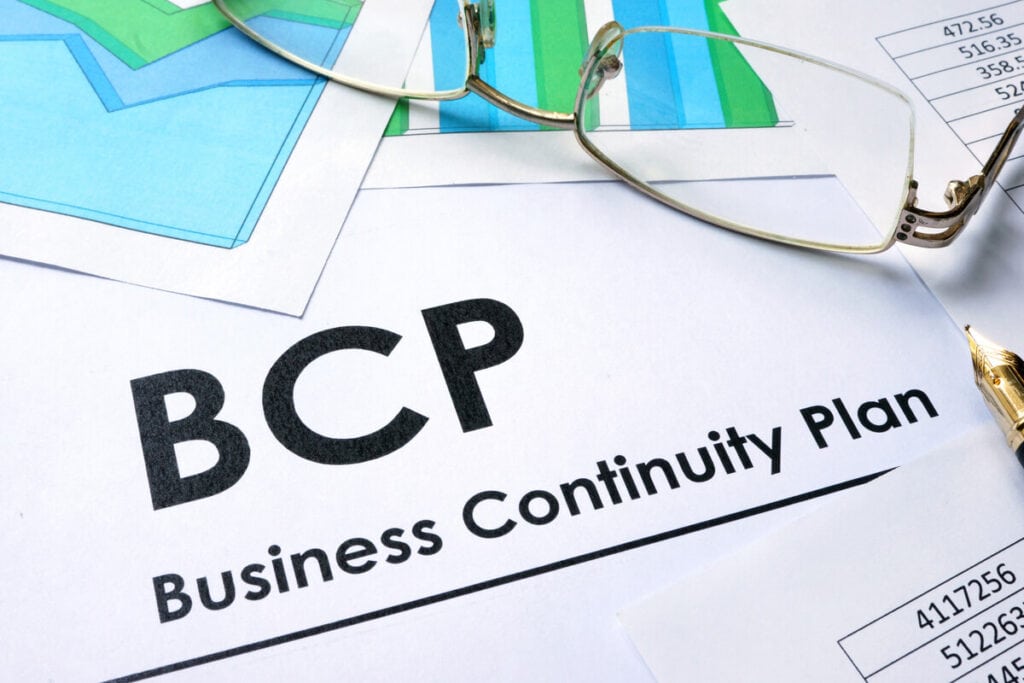Key Highlights
- A business continuity plan (BCP) is a strategic playbook that outlines procedures and instructions for an organization to follow during a disaster or disruption.
- The BCP helps the organization maintain or quickly resume business functions, minimize downtime, and mitigate the impact of the disruption.
- The core team responsible for business continuity planning includes the Business Continuity Manager and the Business Continuity Planning Team.
- Executive oversight is crucial in business continuity planning, with the CEO, CFO, and COO critical in providing strategic direction and support.
- Department heads identify critical functions and risks, ensuring team preparedness and response capability.
- The IT department plays a significant role in business continuity by ensuring technological resilience and implementing IT disaster recovery planning.
- Human resources contribute to business continuity through employee preparedness awareness programs and communication plans.
Table of Contents
ToggleIntroduction
Organizations need a solid business continuity plan (BCP) to navigate disruptions in our highly competitive business environment. A BCP helps manage disasters, be they natural calamities or cyber threats, ensuring minimal downtime and quick recovery of essential functions. Various teams help develop the BCP by identifying risks, devising strategies, and implementing measures for resilience, so this article will address the question of who is responsible for business continuity plans.

What Is a Business Continuity Plan?
A business continuity plan (BCP) is a strategic playbook that helps organizations swiftly maintain or resume business functions during natural disasters, cyberattacks, civic unrest, or terrorist attacks. It minimizes downtime and ensures the continuity of critical business processes.
The BCP complements disaster recovery planning and risk management by proactively identifying risks and developing mitigation strategies.
The BCP’s business impact analysis (BIA) assesses risks to critical functions and prioritizes resources to minimize disruption effects. BCP risk management involves identifying, assessing, and mitigating risks using redundant systems and crisis communication plans.
The Role of a Business Continuity Plan in Organizational Resilience
A BCP is crucial for organizational resilience during disruptive events. It ensures critical operations continue, facilitates response and recovery, and fosters strength post-crisis by identifying risks, mitigating them, and ensuring vital operations’ continuity.
With a robust BCP, organizations minimize disruptions, sustain essential functions, and expedite recovery from natural disasters like floods or earthquakes. Proactive disaster planning reduces financial and operational losses by safeguarding employees and assets.

The Answer to “Who Is Responsible for Business Continuity Plans?”
The core team responsible for business continuity planning includes the Business Continuity Manager and the Business Continuity Planning Team. These individuals play vital roles in developing and implementing the BCP and ensuring its effectiveness, working with and directing other key stakeholders.

The Business Continuity Manager: A Key Figure
The Business Continuity Manager is a crucial figure in the core team responsible for business continuity planning. This individual is typically a senior organization member with the necessary expertise and experience in business continuity management.
The Business Continuity Manager is a leader in developing and implementing the BCP. They provide strategic direction and ensure the plan aligns with the organization’s goals and objectives. The Business Continuity Manager also coordinates with other key personnel and departments to ensure the smooth execution of the plan.
The Business Continuity Manager monitors and evaluates the BCP’s effectiveness, identifies improvement areas, and implements necessary changes. Their expertise and leadership are essential in building a resilient organization that can effectively respond to disruptions and minimize their impact on business operations.

The Business Continuity Planning Stakeholders: Composition and Duties
The Business Continuity Planning Team is a group of individuals responsible for supporting the Business Continuity Manager in developing and implementing the BCP. The team typically consists of representatives from various departments and functions within the organization.
Each team member has specific tasks and responsibilities related to business continuity planning. These tasks may include conducting risk assessments, identifying critical business functions, developing response strategies, and coordinating communication during a disruption. The team members work collaboratively to ensure the BCP addresses all potential risks and provides comprehensive guidance for the organization.
The Business Continuity Planning Team ensures the BCP is practical, effective, and tailored to the organization’s needs. They contribute their expertise and knowledge to the planning process and ensure their own departments can function, helping to create a resilient organization that maintains essential business operations in the face of a disaster.
Executive Oversight in Business Continuity Planning
Executive oversight sets the tone for business continuity planning, critical in providing strategic direction and support. Senior management, including the CEO, CFO, and COO, oversees the development and implementation of the BCP, ensuring it is taken seriously across the organization.

The Critical Involvement of CEO, CFO, CIO, and COO
The CEO, CFO, and COO are vital executive management team members who significantly impact the success of the business continuity planning process. They provide guidance, support, and resources for BCP development and implementation.
- As the top executive, the CEO sets the organization’s strategic direction, prioritizing business continuity as an ongoing operational initiative.
- The CFO ensures the availability of financial resources by assessing the financial impact of potential disruptions compared to the cost of resilience and recovery.
- The COO oversees the day-to-day operations and ensures that the BCP aligns with the organization’s operational goals and that business continuity is adopted within the organization’s culture.
The CEO, CFO, and COO’s leadership and commitment are essential for creating a culture of resilience and ensuring the organization’s ability to respond effectively to and recover from disruptions.
Strategic Direction and Support from the Top
Like the executive team, senior management is crucial in providing strategic direction and support for business continuity planning. They ensure the business continuity strategy aligns with the organization’s goals and objectives and supports their department’s ability to function in the event of an occurrence.
Senior management’s strategic role includes:
- Defining the organization’s priorities,
- Identifying critical business functions,
- Determining the resources needed for business continuity planning.
Senior management’s involvement also helps create a culture of resilience within the organization. By demonstrating their commitment to business continuity, they set an example for employees and promote a proactive and prepared mindset throughout the organization.

Departmental Responsibilities in BCP
Each department within the organization has specific roles and responsibilities to ensure the continuity of its critical business functions. Thus, diving into the details of what’s needed for plan success requires widespread departmental participation.
Identifying Critical Functions and Risks by Department Heads
Department heads deeply understand their departments’ business processes. They are key stakeholders who can assess potential risks and vulnerabilities, help prioritize resources, and develop strategies to ensure the continuity of these functions during a disruption. They also play a key role in conducting risk assessments and implementing risk management measures to mitigate potential threats.
Department heads’ involvement in business continuity planning ensures that the BCP addresses each department’s specific needs and challenges. Their expertise and knowledge are essential for developing practical and effective strategies to maintain business operations during a disruption.
Ensuring Team Preparedness and Response Capability
Department heads are responsible for ensuring team preparedness and response capability within their respective departments, including developing and implementing disaster recovery plans specific to their respective teams.
Team preparedness includes:
- Training employees on their roles and responsibilities during a disruption
- Conducting drills and exercises to test response capability
- Ensuring that employees have access to the necessary resources and information.
Department heads also play a crucial role in coordinating communication and collaboration between business units during a disruption. They work closely with the Business Continuity Planning Team and other department heads to ensure a cohesive and coordinated response to the disruption.
The Role of IT in Business Continuity Management (BCM)
IT systems play a crucial role in business continuity. As organizations increasingly rely on technology for their operations, ensuring the resilience of IT infrastructure and implementing effective disaster recovery measures become paramount.

Ensuring Technological Resilience to Lower Downtime
The IT department is responsible for ensuring technological resilience during business continuity planning. This involves implementing measures to safeguard IT systems and prevent potential system failures that could disrupt business operations.
The IT department is responsible for assessing system vulnerabilities, implementing backup and recovery processes, and ensuring the availability and integrity of critical data. It also plays a crucial role in monitoring and maintaining IT operations to minimize the risk of disruptions.
Using AI for Disaster Recovery Planning
To further enhance resilience, IT business continuity teams can turn to AI to find potential disruptions (particularly from cyber threats) and respond to them while notifying team members of the issue. This innovative approach to business continuity planning helps lower organizational risk.
IT Disaster Recovery Planning (BCDR)
The IT department is responsible for developing and implementing a comprehensive IT disaster recovery plan that outlines the steps and procedures to be followed during a disruption to IT systems. It includes measures to recover IT infrastructure, restore critical applications and data, and minimize downtime.
The IT department also works with department heads and executives to determine the organization’s recovery point objective (RPO) and recovery time objective (RTO). The RPO defines the maximum amount of data loss the organization can tolerate, while the RTO sets the target time for restoring IT operations.

Human Resources’ Contribution to Business Continuity
HR is responsible for ensuring that employees are prepared for disruptions and that effective communication plans are in place.
Employee Preparedness and Awareness Programs
HR’s primary responsibility in business continuity planning is employee preparedness, achieved by developing and implementing awareness programs and training sessions that ensure employees understand their roles and responsibilities during a disruption.
HR’s role in educating employees about business continuity planning and ensuring they are prepared to respond effectively to disruptions is critical to the overall program’s success.
Communication Plans and Personnel Support
HR also plays a critical role in developing and implementing communication plans, ensuring employees receive timely and accurate information during a crisis.
HR is responsible for:
- Coordinating communication efforts
- Disseminating information about the disruption
- Providing updates on the organization’s response,
- Addressing employee concerns and questions.
They also play a crucial role in crisis communication with external stakeholders, such as customers, suppliers, and regulatory bodies.
In addition to communication plans, HR provides personnel support during a disruption. This can include addressing employees’ well-being, ensuring access to necessary resources, and implementing measures to support remote work or alternative work arrangements.
Conclusion
A strong Business Continuity Plan with a dedicated manager and planning team, including executive oversight and departmental responsibilities, is crucial for organizational resilience. The IT organization ensures technological resilience, while Human Resources focuses on employee preparedness and communication. Regular updates and strategic direction from top management lay the foundation for success.
Acknowledging the importance of every role within the organization ensures a comprehensive plan to safeguard operations, mitigate risks efficiently, and achieve the primary goal of business continuity planning: preparing for the worst.




